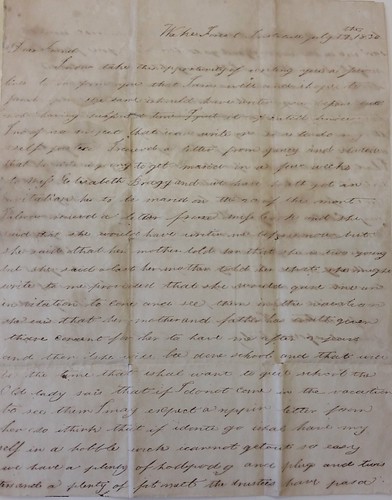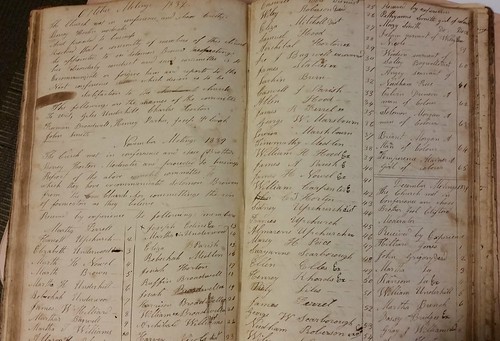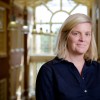This article is more than 5 years old.
This ABC’s of Special Collections blog post was co-authored by Special Collections and Archives intern Brittnee Worthy
H is for…
William F. Higson Letter

According to the 1961 Wake Forest Alumni Directory William F. Higson was a Wake Forest student from 1835-1836. From Hyde County, North Carolina, Higson’s manuscript collection is made up of one handwritten letter from “Wake Forest Institute, July the 17, 1836” started “Dear Friend.” Addressed to Van R. Boddie of Nashville, NC, Higson describes correspondence with mutual friends, plans for upcoming vacation time, and even trustee decisions and student hijinks. Higson also describes Wake Forest’s first President, Samuel Wait, as having an active role in keeping the students in check.
mr wate still watches as much as ever and the boys go to the store more then ever and the old man can not fined them out still he sais there is some that go and will fined them out and he sais that some of them after the girls
Higson goes on to say
I had so much cake for dinner to day i hardly could eat it i should liked to had you her to eat some for it had like to have been as big as my little finger
Clearly, this is a rather conversational letter between Higson and Boddie. Van Renselar Boddie, also listed in the alumni directory as a Wake Forest student from 1835-1836, went on to be a planter in Nash County. He appears to be the first of many Wake Forest attendees from Nash County with the last name Boddie who also became planters. This is very typical of students matriculating through the Wake Forest Institute starting in 1834. An excerpt from The History of Wake Forest College, Volume One describes the “Manual Labor Days” in the following paragraph.
The requirements for admission to the new school and some regulations for its operation had been set out in the meeting of the Convention Board on September 25, 1832. The object of the school was declared to be both to enable young ministers to get an education at moderate cost, and to train youth in general to a knowledge of science and practical agriculture. It was to be open to the reception of all youth of good character; the number for the first year was to be limited to fifty. The minimum age of students was to be twelve years. Every student was to provide himself with an ax and a hoe, a pair of sheets and a pair of towels. Further he was to labor three hours a day under the direction of a scientific farmer, and be subject to the control of the principal teacher who was to be a minister of the Gospel. The total expenses were to be $60 a year, of which $25 was to be paid in advance; but from this total were to be deducted the students earnings as a laborer on the farm. There was to be one vacation from the middle of December to the first of February. As this program had been extensively advertised in the Raleigh Register with the request that is be copied by other papers in the State, and in the Interpreter, as well as at the associations and conventions, the aims and purposes of the Institution were well known throughout the greater part of the State.
Higson and Boddie were typical students of the time. From the very first students enrolled at the Wake Forest Institute, many were sent for a basic education rather than an career in ministry.
Sixteen students registered the first day, and forty within the first few weeks; before the end of the year, seventy-two. Of these students only four were preachers. Only eighteen were professors of religion. Most of the students were sons of farmers, whose parents were doubtless influenced to place their sons at Wake Forest by the considerations that they wold be under religious influence and discipline, learn the habits of industry, and at the same time be instructed to improved methods of farming, all at an expense of $60 a year.
Wait found that their preparation was of different degrees and their objects in coming to the Institute various. Some wished to be prepared for College in as short a time as possible “and others could only, with difficulty, read in a common spelling book.”
We know from the Alumni Directory that Boddie went to be a planter in Nash County, but Higson’s entry merely says Hyde County. According to the 1850 Census records from Hyde County, NC, Higson was a 27 year old merchant living in a shared house surrounded by laborers, merchants, fishermen, and farmers. Working backwards from his age at the time of the census gives us an approximate birth year of 1823, making him approximately thirteen years old while he was writing the letter. Judging by the subject matter, this makes sense.
Not only does William F. Higson’s letter give the reader some sense of Wake Forest’s humble beginnings, it also highlights the (very young) student experience.
H is also for… Hephzibah Baptist Church, Wendell, Wake County, NC

Constituted in 1809 by Elders John Purefoy of Wake Cross Roads and John Gulley of Rocky Springs Church of Johnston County, Hephzibah Baptist originally had ten charter members with John Purefoy elected as pastor. Special Collection’s Hephzibah Baptist Church records consist of a membership/roll book from 1895-1911 and minutes from Dec. 30, 1809 to May 2, 1925. The records include many names and biographical information in relation to the church, making them a great resource for Baptist researchers. There are also at least two recorded African American members who were made Deacons of the church in 1833 and many other recorded African American members.
And H is for… Harold Tedford Collection of Theater Actor Photographs
As the Director of Wake Forest Theatre from 1966-1998, it is no surprise that the Harold Tedford Collection of Theatre Actor Photographs consists of 159 photographs. Harold Tedford’s long theatre and performing arts career began with his studies at Ouachita University in Arkadelphia, AR as a theatre major. Later, he earned his MA at the University of Arkansas and his PhD at Louisiana State University in theatre. From here, Harold Tedford began his work at Southwest Texas State University before joining the Wake Forest University Faculty in 1965.
The photographs in Tedford’s collection range from 1860 to 1910 and provide an interesting look at Victorian and Edwardian Era theatre. Each photograph holds its own personality, many show the actor or actress in character wearing extravagant costumes, while others are portrait photos in their everyday garb. Although the majority of the photographs were taken by Napoleon Sarony, a New York based photographer, Boston and Chicago based studios are also represented in the collection. Many different photography formats are also presented within this collection, including photographic prints and postcards, stereographs, cabinet photographs, and cartes de visite. While the postcards usually contain the most written information, many of the photographs are also annotated on the back, providing information about the actor, performance, or location. Within this collection one can also see the use of hand-coloring, which was a popular method of manually applying color to black and white photographs with either watercolor, dye, crayons, or pastels. This process provided added dimension while also creating a more realistic or artistic appearance to the photograph.

This collection has been digitized and can be viewed on the Theatre Actor Print and Photographs Collection page. Here you can view not only the Harold Tedford Collection of Theatre Actor Photographs, but also prints and photos from similar collections, such as the Harold Seton Collection, the Clarence Herbert New Collection, and the G. Sykes Collection. This is a great resource for anyone interested in or researching 19th and 20th century theatre photography.
Have another topic of interest? Visit our online digital collections to see the wide range of information available at your fingertips or visit us in person at the Special Collections and Archives Research Room (625).



1 Comment on ‘ABCs of Special Collections and Archives: H is for…’
Thanks Brittnee–fascinating collections!